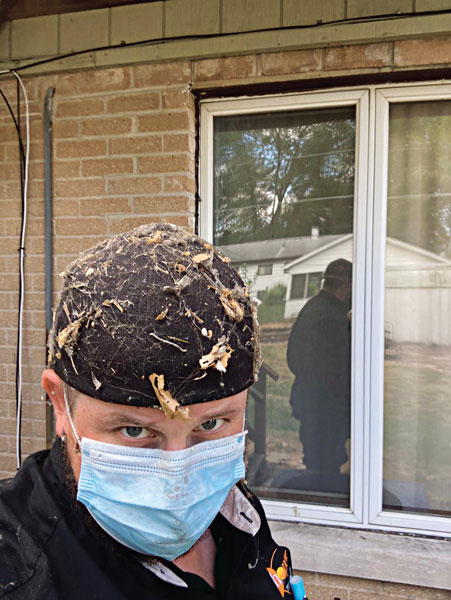
Schopen Pest Solutions’ Observational Biologist Mark Berry proudly emerges from a crawlspace in Wood Dale, Ill., after an inspection. PHOTO: SCHOPEN PEST SOLUTIONS
When was the last time you saw a pest management professional (PMP) portrayed in a positive light? Let’s run down some of the more famous pest control people throughout history:
- Dale Gribble (Johnny Hardwick), “King of the Hill”
- Delbert McClintock (John Goodman), Arachnophobia
- Billy Bretherton, “Billy The Exterminator”
- Bob Duncan (Eric Allan Kramer), “Good Luck Charlie”
And don’t get me started on “Breaking Bad.” I loved the show, but I can’t drive past a tented house now without thinking Bryan Cranston is inside cooking up something illegal.
The only really cool PMP portrayal I can think of was Johnny Rico (Casper Van Dien) in Starship Troopers. At least he helped wipe out an entire planet of bugs with his Morita III Assault Rifle.
Two years ago, I stole an expression from Pest Management Professional Hall of Famer Dr. Bobby Corrigan (Class of 2008). He often refers to PMPs as “observational biologists.” This is my exact sentiment.
I’ve always hated how PMPs are viewed by most of the public. I don’t want my people to just “show up.” I want them to do their jobs with a sense of purpose, some gusto. Or, as I am fond of saying, “working with urgency.”
For about at long as Bobby has been saying “observational biologists,” I’ve been asking my techs, “Do you want to be viewed by people as a step above a garbageman, or a notch below a doctor?” (By the way, there’s nothing wrong with being a sanitation engineer. It is a much-needed service.)
In many ways, we are more like bartenders than doctors or garbage pros. We listen to people’s problems, and then we provide them with a liquid solution (usually). But the truth is, we should be so much more than that. A PMP should be a therapist, chemist, entomologist, landscaper, carpenter, medical examiner, private investigator, wildlife photographer, salesperson, scientist, statistician, sanitation expert, and more. We see so many cool things! Besides Dr. Pimple Popper, what other profession gets people talking about their problems the way pest control does?
I want my team to go home at night knowing they helped their clients. I don’t want them to look in the mirror and think to themselves, “Geez, I’m just a bug man.” They should be thinking, “Man! I got paid a pretty decent wage today to witness some incredible stuff that you usually only see in a National Geographic magazine!” I want them to step up their game and solve difficult problems in client homes and businesses. I want them to use their knowledge and move up the company ladder.
So how do we, as owners, raise our techs from “bug guys” to true professionals? How do we create observational biologists? I have a checklist to get things started:
1. Stick to a dress code. Being a great professional starts with looking like a great professional.
2. Implement a formal training program. At Schopen Pest Solutions, we have a 25-page (and growing) training manual for a program techs must complete by the end of their first month. This is in addition to the many chapters they must read in the Truman’s Guide and other resources.
3, Train with visuals. I’ve been using Google Slides to create hours of material I have downloaded from my smartphone camera over the past few years. I show new techs how to perform a wasp job, how to avoid making a mess with expansion foam, how to hunt down termite tubes, how to vacuum bed bug accounts, etc.
4. Teach like Gordon Ramsey. No, I don’t embarrass and swear at my people. Instead, I coach. Anytime one person makes a mistake, everyone within our company gets brought in on the problem. We take pictures and videos, sending the mishap to everyone via WhatsApp. Obviously, we also send the solution to the group.
5. Let them watch and learn. If there is ever an issue with a client, I never go to the account alone to discuss. I take a tech with me, so he or she can learn how we resolve problems and misunderstandings.
6. Expand their vocabulary. My September 2018 column explains how I text the “word of the day” to all employees. At the end of each month, we have a contest. Some recent words include “repellent,” “waste,” “ootheca” and “diapause.” (Editor’s Note: In July, we posted a vocabulary list from Paul Bello, ACE, BCE, that can give you a good foundation for your team.)
7. Create a video playlist to liven up monthly meetings. There are literally thousands of videos on YouTube from PMPs and entomologists that are worthy of Animal Planet. Show your techs the “10 most-lethal insects” or the “most disgusting bugs” or Eric “Critter” McCool getting stung … again.
8. Most of all, engage your employees. Meet with them one-on-one regularly. Hold “serious” team meetings, but also have fun events like a photo contest for the best pest pic — or the world-famous Schopen Pest Solutions Chili Cook-off!
All these efforts will help ensure your employees stand tall, look their clients in the eye, talk confidently and perform a great service. We really do have the coolest job in the world.
Be safe in 2021.
SCHOPEN is owner and founder of Schopen Pest Solutions, McHenry, Ill. You can email him at pete@schopenpest.com or reach him via Twitter: @schopenpest; Instagram: @peteschopen; or Facebook: Schopen Pest Solutions, Inc.
Leave A Comment